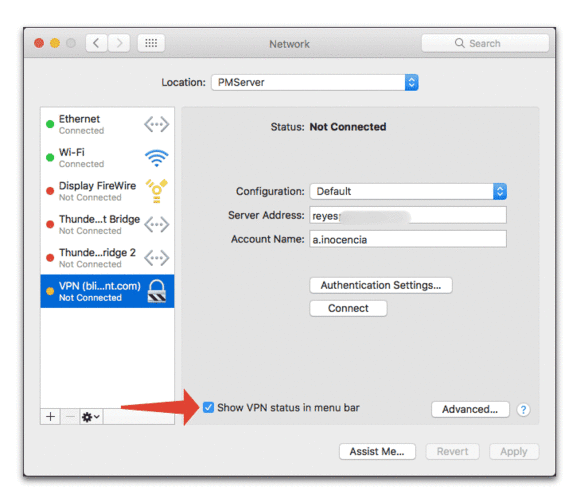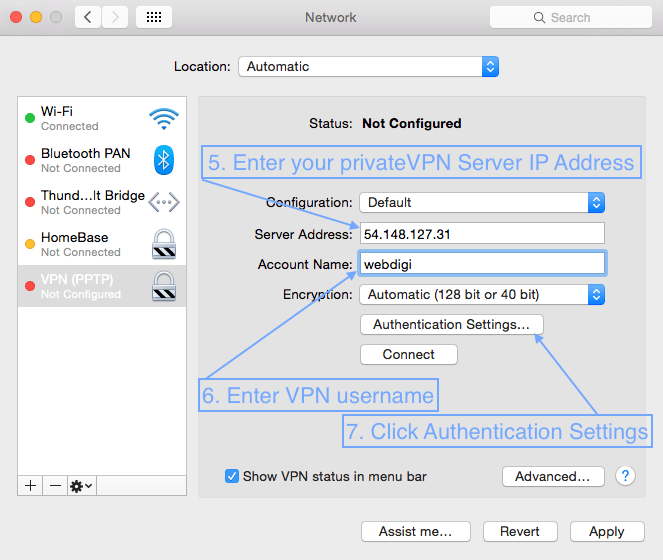

- #Apple server vpn setup install#
- #Apple server vpn setup password#
- #Apple server vpn setup download#
- #Apple server vpn setup mac#
Select it and change Status to Connected.
#Apple server vpn setup password#
After providing the device password to allow system changes, there will be a new “mydomain.tld VPN” profile in Settings – VPN.
#Apple server vpn setup install#
The simplest way to install the profile on an iOS device is by mailing it and tapping the file from within Mail.

It’s also possible to check the “ Show VPN status in menu bar” checkbox, and manage the VPN by clicking the resulting icon. It’s possible to start the VPN connection from here.

When installed, System Preferences – Network will contain a new “network device” called mydomain.tld VPN, with a padlock as an icon.
#Apple server vpn setup mac#
The profile can be installed on a Mac by double-clicking the file and entering administrative credentials to allow it to install. Select the “ Child SA Params” and fill in the following: First set the Integrity Algorithm to SHA2-256 Then set the Encryption Algorithm to AES-256-GCM Diffie-Hellman Group: 20 Lifetime In Minutes: 60 Proxy Setup:

Select the “ IKE SA Params” tab and fill in the following: First set the Integrity Algorithm to SHA2-384 Then set the Encryption Algorithm to AES-256-GCM Diffie-Hellman Group: 20 Lifetime In Minutes: 720 Proxy Setup: VPNĬonnection Name: mydomain.tld VPN Connection Type: IKEv2 Always-on VPN: Unchecked Server: Remote Identifier: Local Identifier: Machine Authentication: Certificate Certificate Type: RSA Server Certificate Issuer Common Name: Server Certificate Common Name: Enable EAP: Checked Disconnect on Idle: Optional – I have it set to Never EAP Authentication: Certificate Identity Certificate: Select your Client certificate Dead Peer Detection Rate: Medium Disable redirects: Unchecked Disable Mobility and Multihoming: Unchecked Use IPv4 / IPv6 Internal Subnet Attributes: Unchecked Enable perfect forward secrecy: Unchecked Enable certificate revocation check: Unchecked Disable redirects: Unchecked Disable Mobility and Multihoming: Unchecked Use IPv4 / IPv6 Internal Subnet Attributes: Unchecked Enable perfect forward secrecy: Unchecked Enable certificate revocation check: Unchecked When adding the latter, we also need to enter the export pass phrase. Using the “+” button, add the Root CA certificate (“ mydomain+VPN-root-CA+.crt“), the Server certificate (“” mydomain+VPN-server+.crt“), and the client certificate bundle we generated earlier (“ mydomain+VPN-client+.p12“). Name: mydomain.tld VPN Identifier: Certificates Start the program and create a new profile. This step requires a Mac with Apple Configurator 2 installed. Generate a secure one and store it in your password manager along with the certificate files. You will be asked for an export passphrase. Open a Terminal and run the following two commands: $ cd ~/Downloads This will store “ mydomain+VPN-client+” and “ mydomain+VPN-client+.key” in your Downloads directory.
#Apple server vpn setup download#
This time download both the certificate (represented by the round seal icon” and the private key (represented by a key icon). Now for the only bit of shell magic we’ll need to do: Client certificate You will now have an additional file called “ mydomain+VPN-server+.crt” in your Downloads directory. Then select the “ Certificates” tab and do the same for the server certificate we created earlier. crt file named something akin to “ mydomain+VPN-root-CA+.crt“ Press it, and your browser will download a. We’re interested in the middle one that represents a round seal. Next to the “ mydomain VPN-root-CA ” certificate we created earlier, there’s a row of blue icons. The VPN host in this case already has the client’s public key since we generated the client key-pair locally on the host. Then we need a copy of the Server certificate’s public key to be able to establish an encrypted connection to it from the client. CA and Server certificatesĪs usual with a PKI-based solution, we need to trust the Root certificate to trust any certificates signed by the Root. We’ll start by getting the necessary certificates. Specifically, we’ll create an Apple configuration profile that we can deliver to devices that we want to use as VPN clients. Now we’ll look at what needs to be done to get the clients to actually connect. In the first part, we configured the pfSense firewall to allow clients to establish secure VPN connections to it.


 0 kommentar(er)
0 kommentar(er)
